Abstract
BACKGROUND: There is some evidence that the perception of bronchoconstriction may very according to the nature of the provoking stimulus. The aims of this study were, firstly, to develop a method for measuring dyspnoea during induced bronchoconstriction in patients with asthma and, secondly, to apply this method to testing differences between directly and indirectly acting bronchoconstricting stimuli. METHODS: Descriptive terms suitable for quantifying respiratory discomfort due to bronchoconstriction in patients with asthma were identified in a preliminary investigation. The relation between reduction in forced expiratory volume in one second (FEV1) and respiratory discomfort, measured using a visual analogue scale (VAS), was then studied during challenges with three different inhaled stimuli: methacholine (MCH), sodium metabisulphite (MBS), and adenosine monophosphate (AMP). Three indices were calculated to describe the relation: the VAS value associated with a 20% fall in FEV1 (FEV20 VAS); the ratio of the final VAS value to the final percentage fall in FEV1 (VAS-FEV1 ratio); and the regression coefficient for predicting VAS from the percentage fall in FEV1 within each challenge (beta VAS FEV1). RESULTS: "Difficulty in breathing" and "chest tightness" were selected as suitable terms for quantifying respiratory discomfort. There were no differences between the three agonists in the qualitative aspects of the respiratory sensation. In paired challenges with the same agonist the three indices were all found to be reproducible for both sensations measured. MCH induced less intense difficulty in breathing and chest tightness for a given fall in FEV1 than did AMP. There was a trend in the same direction for the comparison between MCH and MBS. There were no differences between AMP and MBS. FEV20 VAS was less powerful in discriminating between agonists than the two slope indices. CONCLUSIONS: The relation between induced reduction in FEV1 and the intensity of respiratory discomfort can be measured reliably. The indirectly acting bronchoconstricting agonists AMP and MBS induced more intense respiratory discomfort for a given fall in FEV1 than the direct agonist MCH. This may be due to differences in unmeasured mechanical changes in the lungs or to an additional action on airway sensory nerves.
Full text
PDF
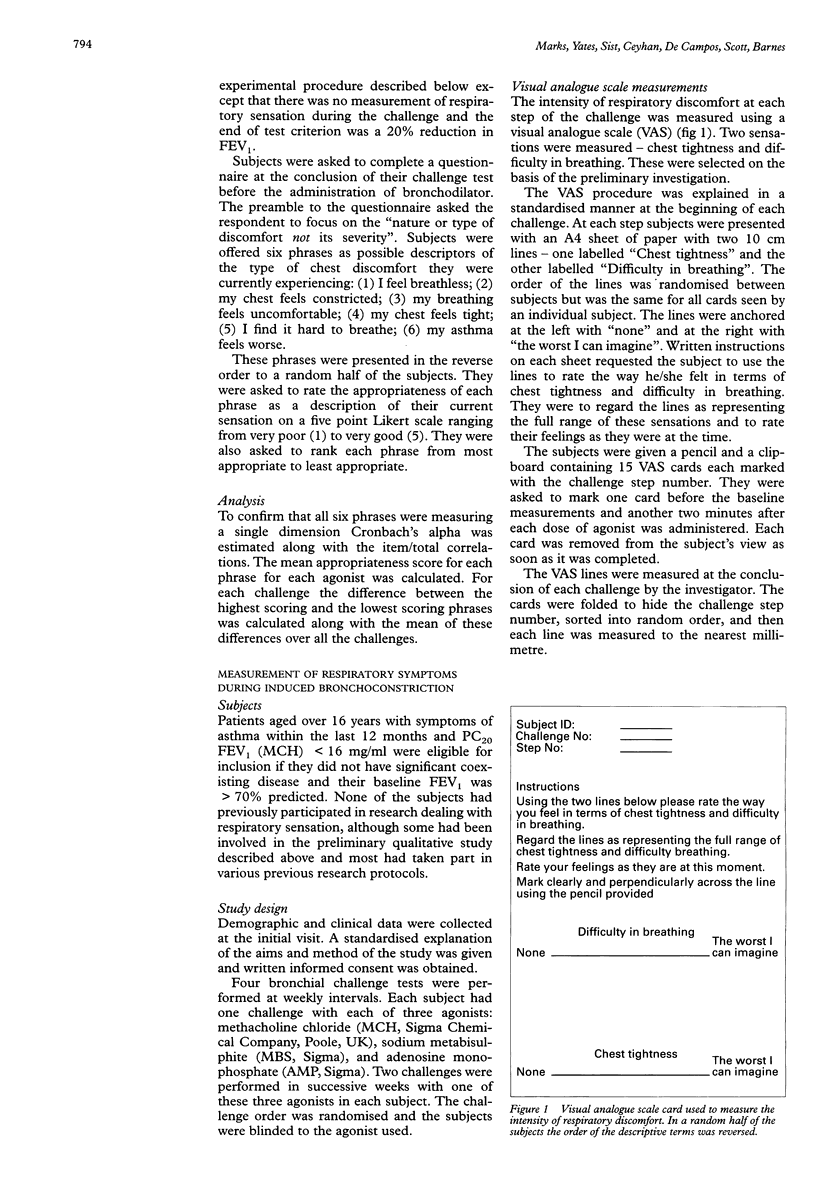
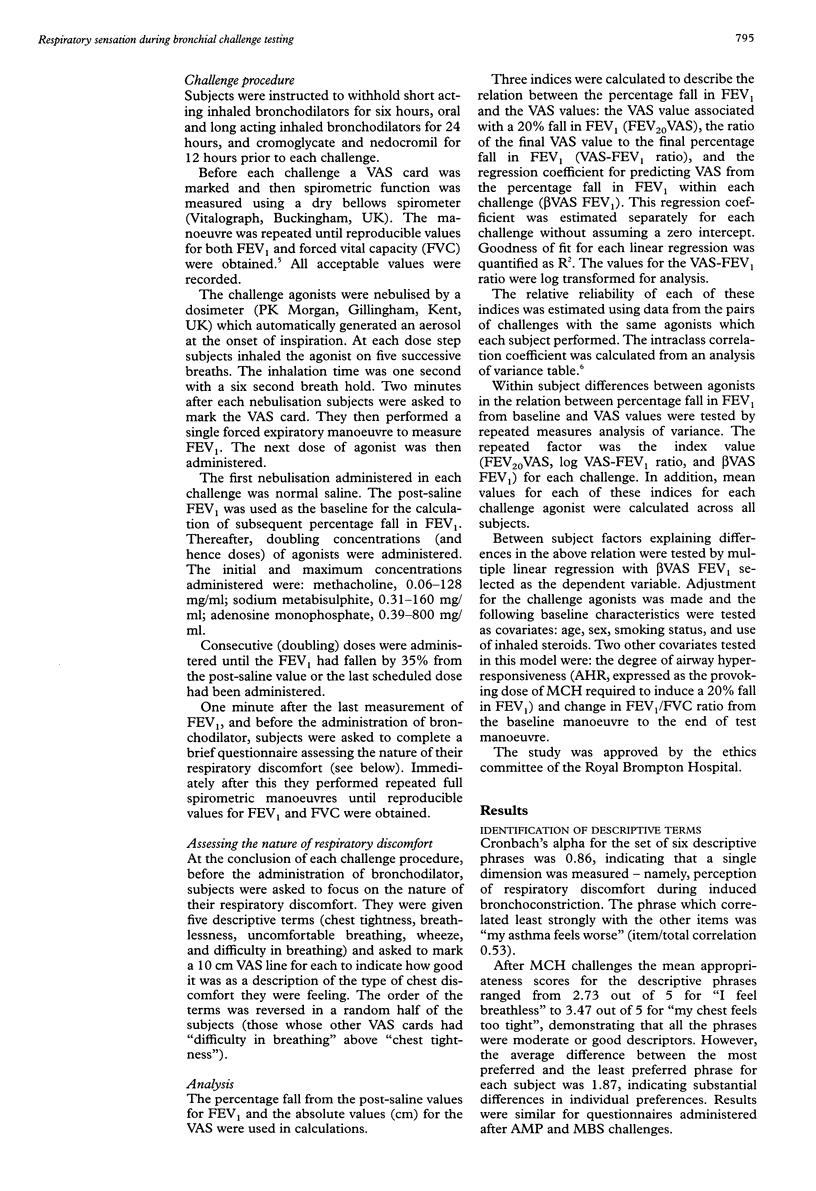
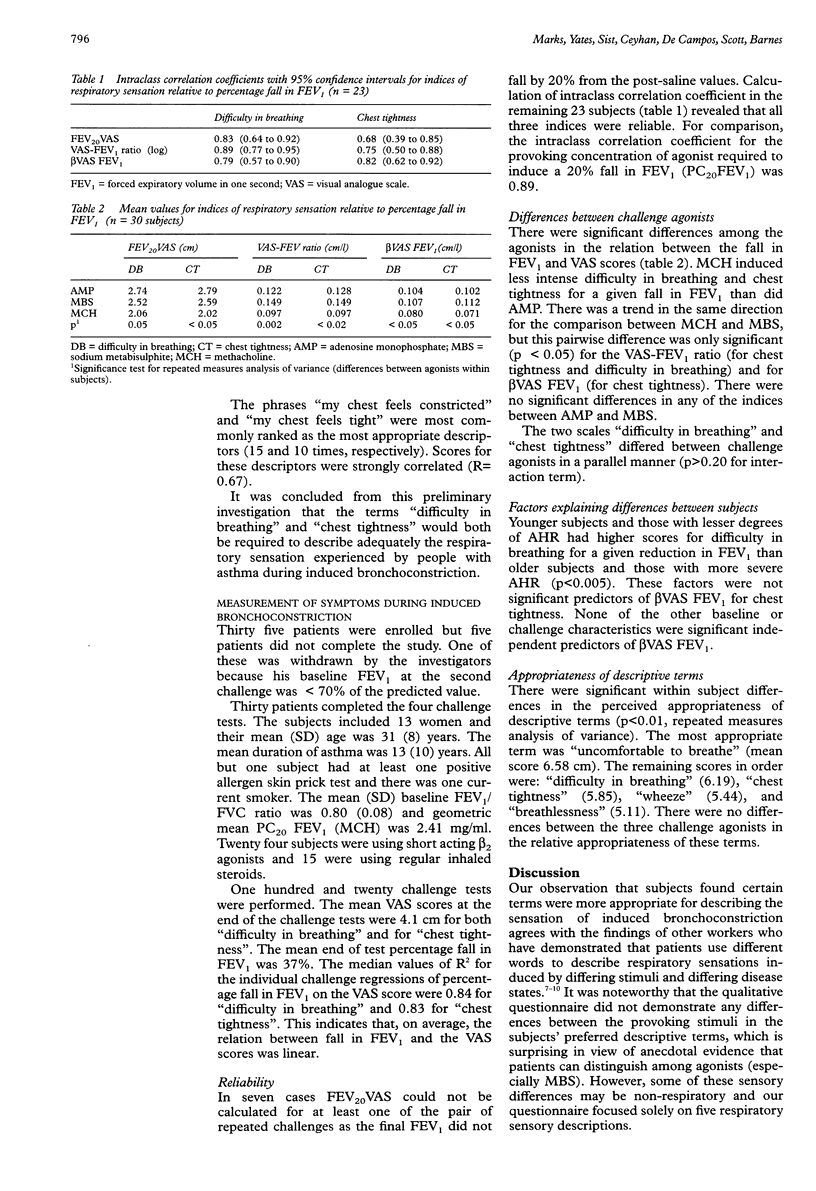
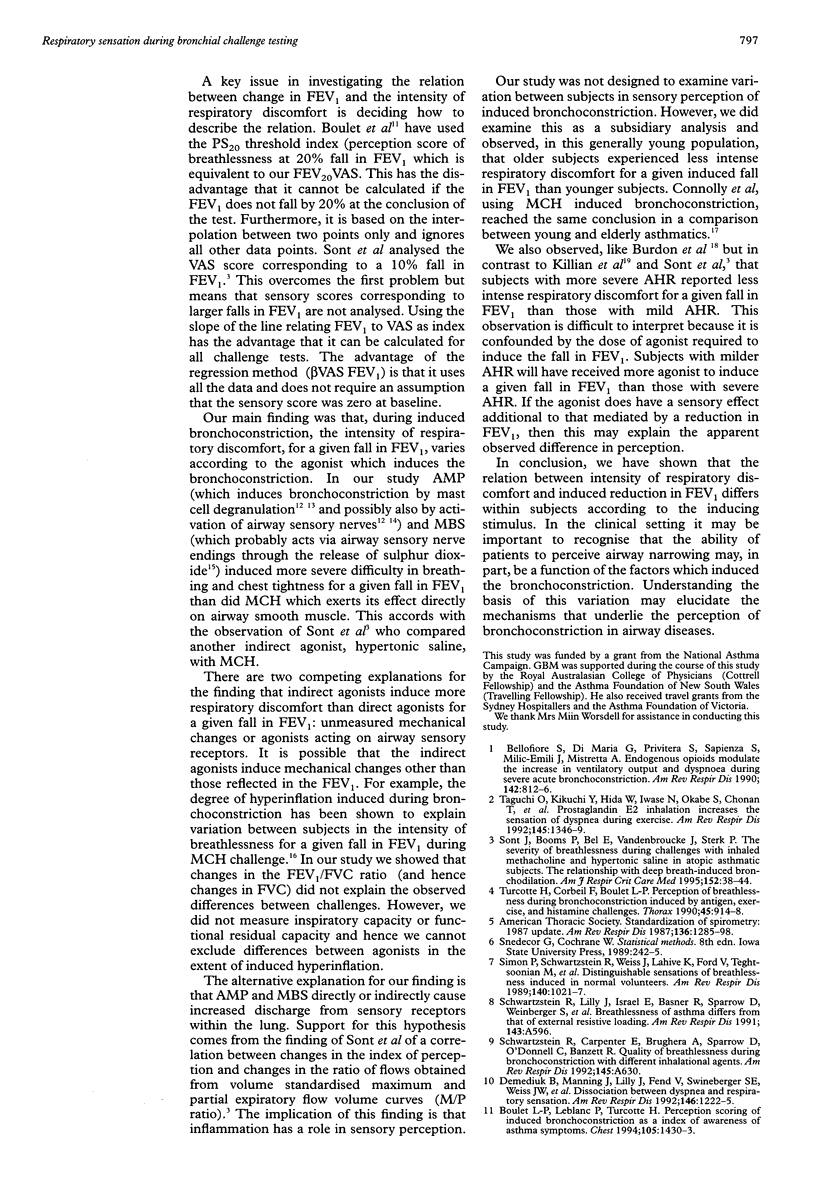
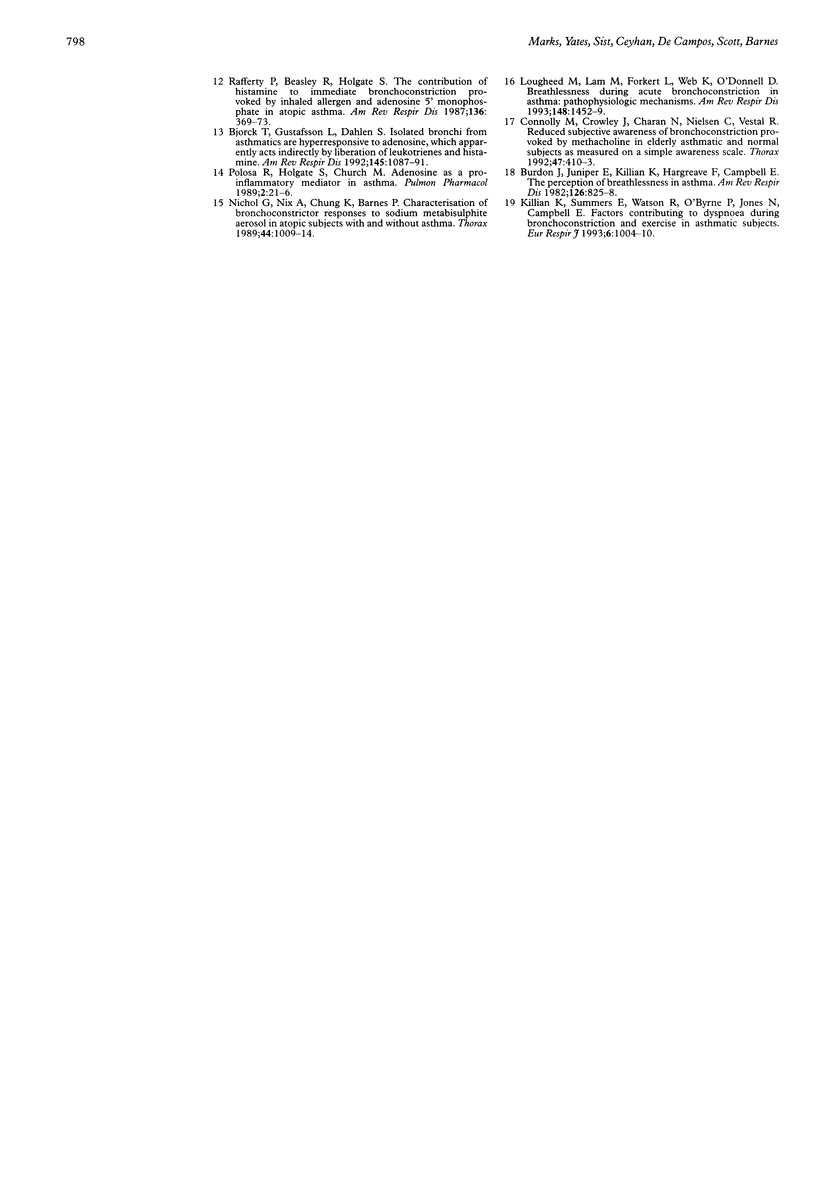
Selected References
These references are in PubMed. This may not be the complete list of references from this article.
- Bellofiore S., Di Maria G. U., Privitera S., Sapienza S., Milic-Emili J., Mistretta A. Endogenous opioids modulate the increase in ventilatory output and dyspnea during severe acute bronchoconstriction. Am Rev Respir Dis. 1990 Oct;142(4):812–816. doi: 10.1164/ajrccm/142.4.812. [DOI] [PubMed] [Google Scholar]
- Björck T., Gustafsson L. E., Dahlén S. E. Isolated bronchi from asthmatics are hyperresponsive to adenosine, which apparently acts indirectly by liberation of leukotrienes and histamine. Am Rev Respir Dis. 1992 May;145(5):1087–1091. doi: 10.1164/ajrccm/145.5.1087. [DOI] [PubMed] [Google Scholar]
- Boulet L. P., Leblanc P., Turcotte H. Perception scoring of induced bronchoconstriction as an index of awareness of asthma symptoms. Chest. 1994 May;105(5):1430–1433. doi: 10.1378/chest.105.5.1430. [DOI] [PubMed] [Google Scholar]
- Burdon J. G., Juniper E. F., Killian K. J., Hargreave F. E., Campbell E. J. The perception of breathlessness in asthma. Am Rev Respir Dis. 1982 Nov;126(5):825–828. doi: 10.1164/arrd.1982.126.5.825. [DOI] [PubMed] [Google Scholar]
- Connolly M. J., Crowley J. J., Charan N. B., Nielson C. P., Vestal R. E. Reduced subjective awareness of bronchoconstriction provoked by methacholine in elderly asthmatic and normal subjects as measured on a simple awareness scale. Thorax. 1992 Jun;47(6):410–413. doi: 10.1136/thx.47.6.410. [DOI] [PMC free article] [PubMed] [Google Scholar]
- Demediuk B. H., Manning H., Lilly J., Fencl V., Weinberger S. E., Weiss J. W., Schwartzstein R. M. Dissociation between dyspnea and respiratory effort. Am Rev Respir Dis. 1992 Nov;146(5 Pt 1):1222–1225. doi: 10.1164/ajrccm/146.5_Pt_1.1222. [DOI] [PubMed] [Google Scholar]
- Killian K. J., Summers E., Watson R. M., O'Byrne P. M., Jones N. L., Campbell E. J. Factors contributing to dyspnoea during bronchoconstriction and exercise in asthmatic subjects. Eur Respir J. 1993 Jul;6(7):1004–1010. [PubMed] [Google Scholar]
- Lougheed M. D., Lam M., Forkert L., Webb K. A., O'Donnell D. E. Breathlessness during acute bronchoconstriction in asthma. Pathophysiologic mechanisms. Am Rev Respir Dis. 1993 Dec;148(6 Pt 1):1452–1459. doi: 10.1164/ajrccm/148.6_Pt_1.1452. [DOI] [PubMed] [Google Scholar]
- Nichol G. M., Nix A., Chung K. F., Barnes P. J. Characterisation of bronchoconstrictor responses to sodium metabisulphite aerosol in atopic subjects with and without asthma. Thorax. 1989 Dec;44(12):1009–1014. doi: 10.1136/thx.44.12.1009. [DOI] [PMC free article] [PubMed] [Google Scholar]
- Polosa R., Holgate S. T., Church M. K. Adenosine as a pro-inflammatory mediator in asthma. Pulm Pharmacol. 1989;2(1):21–26. doi: 10.1016/s0952-0600(89)80005-5. [DOI] [PubMed] [Google Scholar]
- Rafferty P., Beasley R., Holgate S. T. The contribution of histamine to immediate bronchoconstriction provoked by inhaled allergen and adenosine 5' monophosphate in atopic asthma. Am Rev Respir Dis. 1987 Aug;136(2):369–373. doi: 10.1164/ajrccm/136.2.369. [DOI] [PubMed] [Google Scholar]
- Simon P. M., Schwartzstein R. M., Weiss J. W., Lahive K., Fencl V., Teghtsoonian M., Weinberger S. E. Distinguishable sensations of breathlessness induced in normal volunteers. Am Rev Respir Dis. 1989 Oct;140(4):1021–1027. doi: 10.1164/ajrccm/140.4.1021. [DOI] [PubMed] [Google Scholar]
- Sont J. K., Booms P., Bel E. H., Vandenbroucke J. P., Sterk P. J. The severity of breathlessness during challenges with inhaled methacholine and hypertonic saline in atopic asthmatic subjects. The relationship with deep breath-induced bronchodilation. Am J Respir Crit Care Med. 1995 Jul;152(1):38–44. doi: 10.1164/ajrccm.152.1.7599850. [DOI] [PubMed] [Google Scholar]
- Taguchi O., Kikuchi Y., Hida W., Iwase N., Okabe S., Chonan T., Takishima T. Prostaglandin E2 inhalation increases the sensation of dyspnea during exercise. Am Rev Respir Dis. 1992 Jun;145(6):1346–1349. doi: 10.1164/ajrccm/145.6.1346. [DOI] [PubMed] [Google Scholar]
- Turcotte H., Corbeil F., Boulet L. P. Perception of breathlessness during bronchoconstriction induced by antigen, exercise, and histamine challenges. Thorax. 1990 Dec;45(12):914–918. doi: 10.1136/thx.45.12.914. [DOI] [PMC free article] [PubMed] [Google Scholar]


